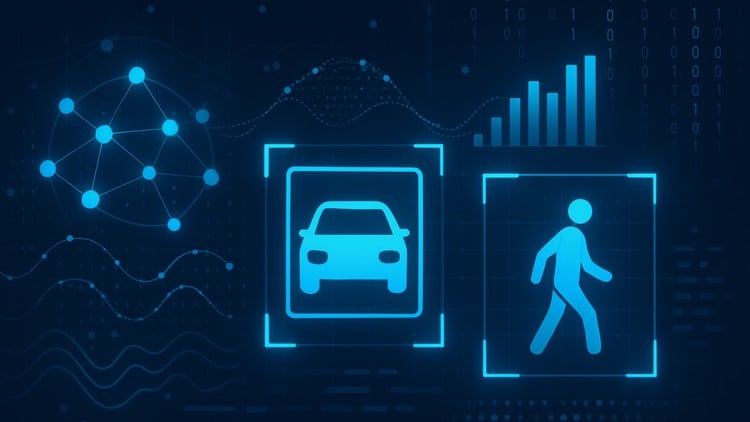
Object Detection | Machine learning | computer vision | Deep learning
⏱️ Length: 2.0 total hours
👥 2,006 students
🔄 October 2025 update
Add-On Information:
Note➛ Make sure your 𝐔𝐝𝐞𝐦𝐲 cart has only this course you're going to enroll it now, Remove all other courses from the 𝐔𝐝𝐞𝐦𝐲 cart before Enrolling!
- Course Overview
- Rapidly navigate the core concepts of object detection, understanding how machines perceive and localize objects within visual data, from foundational principles to practical implementation. This course demystifies the integration of machine learning, computer vision, and deep learning for robust visual recognition.
- Embark on a hands-on journey to master the efficient development of object detection models, leveraging cutting-edge deep learning techniques for real-world applications within a concise 2-hour duration. The program is specifically designed for rapid skill acquisition and immediate practical application.
- Discover a streamlined pathway to integrating machine learning and computer vision to solve complex visual recognition challenges. Despite its brevity, the course promises a comprehensive overview, focusing intently on actionable insights and practical model building.
- Requirements / Prerequisites
- A working knowledge of Python fundamentals, including basic syntax, data structures (lists, dictionaries), and function definitions, is essential for engaging effectively with the practical coding exercises.
- Familiarity with core machine learning concepts such as model training, evaluation metrics, and the principles of supervised learning will provide a strong contextual foundation for the course material.
- While not strictly mandatory, a conceptual understanding of neural networks and the basics of deep learning would be advantageous for contextualizing the advanced models utilized within the curriculum.
- Access to a reliable internet connection and a computational environment capable of running Python code and deep learning libraries, such as Google Colab or Jupyter Notebooks, is required for hands-on practice.
- No prior specific experience with computer vision libraries, advanced deep learning frameworks, or object detection methodologies is needed, making this course genuinely accessible for determined beginners in the field.
- Skills Covered / Tools Used
- Understanding Object Detection Paradigms: Gain insight into the fundamental differences and trade-offs between various object detection approaches, such as one-stage versus two-stage detectors, on a conceptual level.
- Bounding Box Annotation Principles: Learn the practical standards and best practices for creating, validating, and managing accurate bounding box annotations, which are critical for effective model training and performance.
- Advanced Data Augmentation for Localization: Implement specialized data augmentation strategies, like random cropping, geometric transformations, and color perturbations, ensuring bounding box integrity while significantly increasing dataset diversity and model robustness.
- Fine-tuning Pre-trained Models: Master the highly efficient technique of adapting powerful pre-trained convolutional neural networks to new, specific object detection tasks, drastically reducing training time and data requirements for custom scenarios.
- Interpreting Model Confidence Scores: Develop the ability to analyze and interpret the confidence scores generated by detection models, understanding their implications for decision-making, result filtering, and thresholding strategies.
- Visualizing Detection Results Effectively: Acquire practical skills in graphically presenting model predictions, accurately drawing precise bounding boxes and displaying class labels alongside confidence scores directly onto images for qualitative assessment and debugging.
- Optimizing Training Workflows with Callbacks: Utilize fastai’s robust callback system to implement advanced training techniques such as learning rate scheduling, early stopping based on performance metrics, and automatic model checkpointing for robust and efficient development.
- Evaluating Performance with mAP: Grasp the practical calculation and significance of Mean Average Precision (mAP) and its underlying components (Intersection over Union (IoU), precision, recall), enabling accurate quantitative assessment of your object detection models.
- Managing Different Backbones and Heads: Learn to interchange various deep learning backbones (e.g., ResNet, EfficientNet) and detection heads within the flexible IceVision framework, understanding their impact on model performance, efficiency, and computational cost.
- Introduction to Deployment Considerations: Understand initial steps and conceptual considerations involved in taking a trained object detection model from the development environment to a production setting for real-time inference, including basic optimization ideas.
- Addressing Common Detection Challenges: Gain practical strategies for overcoming prevalent hurdles in object detection, such as effectively handling small objects, managing occlusions, and accurately detecting objects across varying scales within images.
- Benefits / Outcomes
- You will be equipped to confidently build and experiment with your own object detection models for diverse applications, ranging from identifying objects in still images to tracking them in video streams.
- Develop a strong practical foundation in a critical and rapidly expanding domain of artificial intelligence, significantly enhancing your capabilities in both machine learning and computer vision.
- Acquire the ability to rapidly prototype and test various object detection solutions, significantly shortening development cycles for your personal projects, academic endeavors, and professional assignments.
- Enhance your professional portfolio with a highly valuable and in-demand skill in computer vision, opening doors to advanced roles in AI, robotics, autonomous systems, security, and advanced analytics.
- Cultivate an intuitive understanding of how deep learning architectures perform complex visual recognition tasks, moving beyond theoretical knowledge to hands-on mastery and practical problem-solving.
- PROS
- Ultra-Concise Learning Path: Achieves significant practical skill acquisition in a remarkably short 2-hour timeframe, making it ideal for busy individuals.
- Action-Oriented Curriculum: Focuses entirely on hands-on implementation and immediate application using robust, modern libraries like IceVision and fastai.
- Modern Toolkit Proficiency: Equips learners with practical expertise in industry-relevant, high-level frameworks, abstracting complexity for rapid development.
- Accelerated Skill Development: Designed for quickly adding a powerful computer vision capability to your existing knowledge base for immediate project contributions.
- Foundation for Advanced Study: Provides a strong, practical springboard for further exploration into more specialized and intricate object detection topics.
- CONS
- Conceptual Depth Trade-off: The accelerated nature means less time for in-depth theoretical explorations or mathematical proofs behind underlying algorithms, requiring external study for a deeper academic understanding.
Learning Tracks: English,IT & Software,Other IT & Software
Found It Free? Share It Fast!